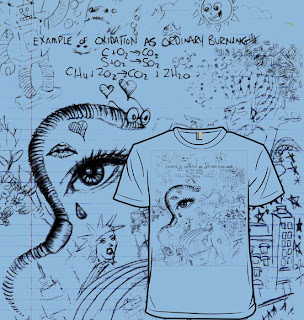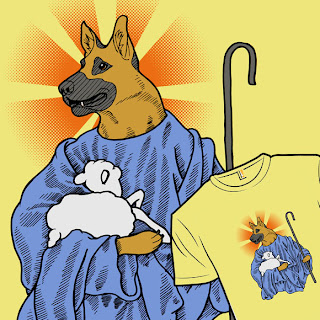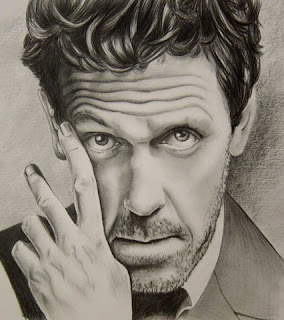Graphite pencils are a wonderful medium to work with. They're cheap, they last a long time and you can put them down, do a diaper change, and pick right back up where you left off. No muss, no fuss. That is probably the sole reason I worked almost exclusively in graphite for the first few years as a fan artist.
My pencils of choice are Lyra Titan woodless. I usually sketch with an HB, shade with the 4B and then fill in the darker spaces with the 6B.
(These are just pictures off the internet, btw, I was too lazy to take pics myself.) I really like the kneaded erasers, although I'm not fussy about brand.
And for blending large areas, nothing beats papertowel. I'm quite fond of the Kirkland brand, but that's probably just because that's the type I have hanging around the house. I find it better than kleenex or toilet paper, because it doesn't shred and leave little bits lying around.
I also use a little make up brush for blending the smaller areas. I don't have a picture, but it's the little foam q-tip type thing that you get when you buy eye shadow. You can buy them on their own from Wal-Mart for a buck or two.
I learn a lot by seeing how other people work, so I thought I'd post up a couple of WIPs (works in progress) that I've made in the last couple of years. Generally, I"m terrible at stopping and taking photos, so the fact that I have a few of these is pretty amazing.
I start by sketching out the subject at hand. No, that's a lie. I start by finding a great reference photo. I'm not a good enough artist to just draw from my head (at least, in a realistic fashion) and the better the ref photo, the better the finished product. Anyhoo, I sketch out what I'm going to draw before I begin shading. I've found over the past few years, I'm less careful about the initial sketch that I used to be. I'm getting a bit better at being less rigid.
I'm sure this is terrible form, but I pretty much always start with the eyes. That's kind of like eating desert before the main meal, but to me, the eyes are the most important part of a portrait and if they don't look good, there's no reason to keep going.
This picture was my first time drawing Hugh Laurie (House) and I wasn't even very familair with the show, but he has a cool face, so I wanted to draw him. Notice on this pic, the shading on the nose. It's very dark underneath, and it's shaded above too, but there's a highlight on the bottom edge that really makes it pop. This isn't something I made up, it was part of the ref pic.
The initial sketch had his nose and chin drawn way too long, so I've shortened them up considerably. (before drawing them in dark.) A craggy, wrinkly face like his is easier to draw, than say, his co-host RSL (Wilson), who has lovely, smooth features. I find that faces with well defined landmarks, like wrinkles, scruff, scars and folds help me to determine where I am, in relation to the rest of the face. the more landmarks there are, the more I know if my proportions are correct.
Here's another example of the EVIL HAND. Again, notice the highlights on each side of each finger, that really define them and give them dimension.
The blue mark on the bottom of this one is where my original sketch had the bottom of his chin. The dude does have a long face, but this would have been a disaster! Also, I suck at backgrounds, but shading in the side behind the highlighted area on his face makes it stand out more.
And here's the fnished product. I wish I had specific advice on how to draw the different details, but I really don't. I really just try to draw what I see.
Here's a couple of tips that don't really apply to this drawing, but apply to ALL drawings.
1) Never draw a straight line. At least, not on something that occurs in nature. Even lines that appear to be one thickness and arrow straight are generally more organic than that. Take, for example, his nasolabial folds. When I first started drawing, I probably would have just drawn them as lines, but even where they are deepest, say by his mouth, they still create shadows that blend in at different values, and they're not as straight as they first appear to be.
2) Your eraser is not just for fixing mistakes. I use my kneaded eraser as a drawing tool. I picked out bits of beard to create highlights, I cleaned up lines, I pulled the light spots out of his eyes to make them more .. liquidy, and added the shine to his hair. I probably use my eraser as much as I do my pencil.
3) Draw in the direction that you are going. Wow, that was badly worded, but hopefully you get my point. Look at his suit jacket. The shading lines move in the direction that the material moves. It's counter-intuitive to shade in lines that go against the grain of the drawing, unless you're doing it on purpose, for effect.
Here's a WIP of my son, Harrison. Click on these to get a larger, more detailed pic.
Oh! Another tip: DON'T BE AFRAID OF DARKS! I've seen lots of people who are great line artists, who wimp out on the shading, and it really makes their art look crappy. A really great picture should have all of the values. The darkest darks and the lightest lights.
Good old Snapey-poo. I owe all my artistic talents to him, because it was a desire to draw a passable Snape that motivated me to pick up a pencil in the first place. But that's for a different post.
TL;DR PENCILS ARE FUN!













































